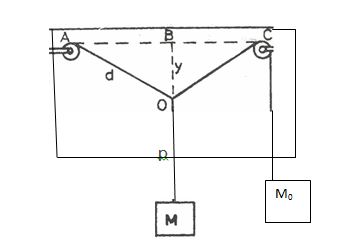|
|
Alternative b
Question 4
|
(a) Diagram

Using the above diagram as a guide, carry out the following instructions.
(i) Attach the mass Mo to one end of the thread provided. Fix the other end of the thread to
pulley a on the force board. Pass the thread through pulley C.
(ii) Hang the force board vertically. Fix a drawing paper on the board behind the thread.
(iii)Draw a line on the paper along the direction of AC. Locate and mark the mid point B of
line AC.
(iv)Draw a normal to AC at B.
(v)By means ofa loop of thread, suspend mass M = 70 g from AC. Adjust the position of
the loop so that the line of action of the weight of M lies along BP, the normal to A C.
(vi)Ensure that M and Mo hand off the force board. Trace the paths AO, OC and OP of the
thread.
(vii) Measure and record y = BO. Also measure and record d = AO.
(viii) Evaluate 1 = y /d
(ix)Repeat the procedure for other values of M = 100, 120, 150 and 170g.
(x) Tabulate your readings.
(xi)Plot a graph with I on the vertical axis and M on the horizontal axis.
(xii) Determine the slope, s, of the graph.
(xiii)State two precautions taken to ensure accurate results.
(attach your traces to your answer booklet.)
(b )(i) State parallelogram law of vector addition.
(ii) State the conditions necessary for a body to be in equilibrium when acted upon by a number
of parallel coplanar forces
|
| _____________________________________________________________________________________________________ |
|
This question was well attempted by many candidates.
OBSERVATIONS [11]
(i) Five complete drawings showing AO and AC at right angles to BP.
(ii) Five values ofy = BO correctly measured and recorded in em
to at 1 decimal place and in trend,
(Trend: yincreases as M increase)
(iii) Five values of d = AO measured and recorded in em to at
least 1 decimal place and in trend.
(Trend; d increases as M increase)
(iv) Five values of L = y/d correctly evaluated and recorded to
at least 2 decimal places.
(vii) Composite and complete table showing M, y, d and L
Note: If no traces attached, award zero for (i) - (iii)
GRAPH (05)
(i) Axes correctly distinguished 1/2 mark each
(ii) Reasonable scales, ':1/2 mark each
(iii) Five points correctly plotted
(iv) Line of best fit
SLOPE (02)'
(i) Large right angled triangle
(ii)∆L correctly read and recorded
(iii)∆M correctly read and recorded
(iv) ∆L/∆Mcorrect1y evaluated
ACCURACY [Oll
Based on slope = 1/(2M0) to within ± 10% of supervisor's value of M,
PRECAUTIONS [02]
Award 1 mark each for any two correct precautions e.g
Force board firmly fixed.
Parallax error avoided in reading metre rule
Ensured M and M0were at rest before taking readings
Zero error was noted and corrected on the metre rule
Ensured AC was horizontal
Neat drawings
(Accept any other valid precaution).
(b) (i) The parallelogram law of vector addition states that if two vectors are represented in
both magnitude and direction by the adjacent sides of a parallelogram, the resultant of
the vectors is represented in magnitude and direction by the diagonal of the
parallelogram drawn from the common point.
(ii)For a body to be in equilibrium under the action of parallel
Coplanar forces the sum of the forces in one direction (sum of upward forces) must be equal to
the sum of the forces in the opposite direction (sum of downward forces).
the algebraic sum of the moments about any point is equal to zero.
(OR the sum of clockwise movements about any point is equal to the sum of
anti clockwise movements about the same points].
|
|
|
|



